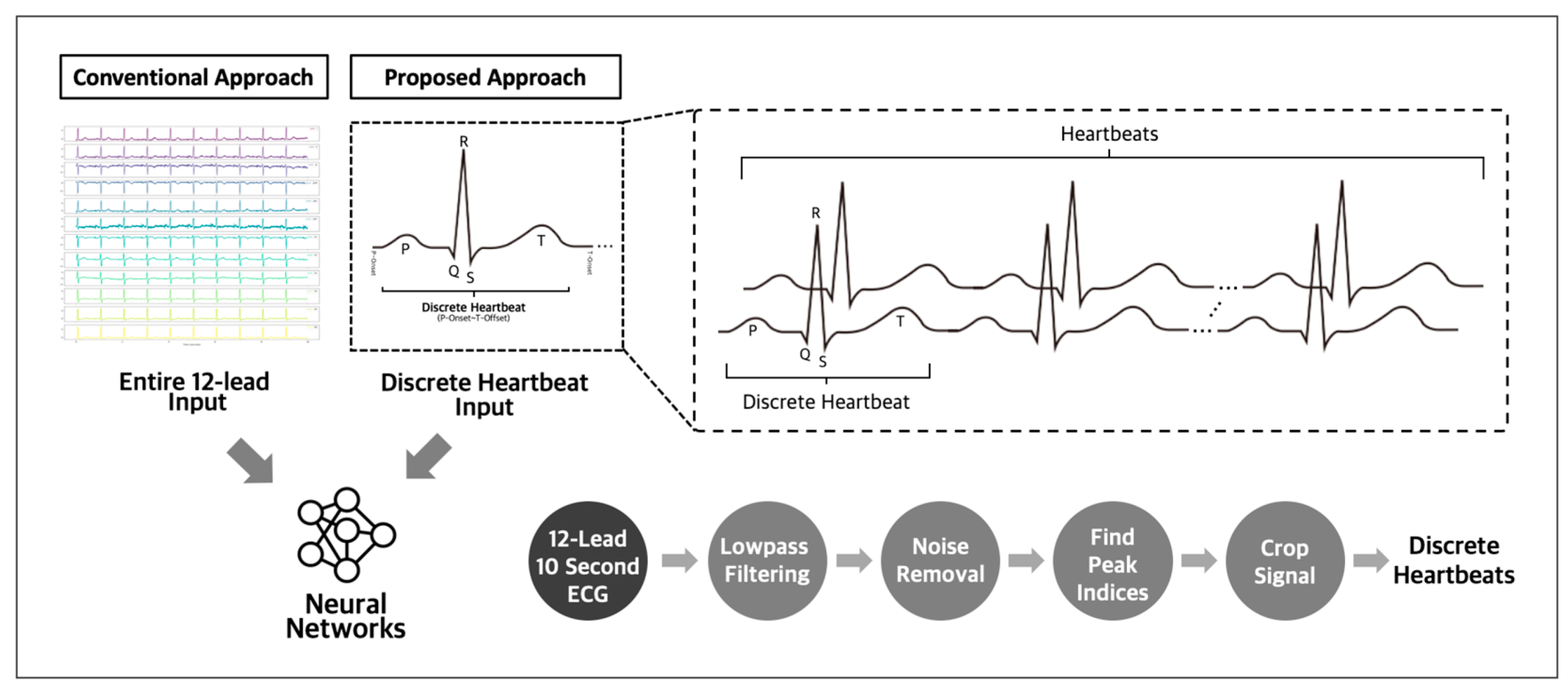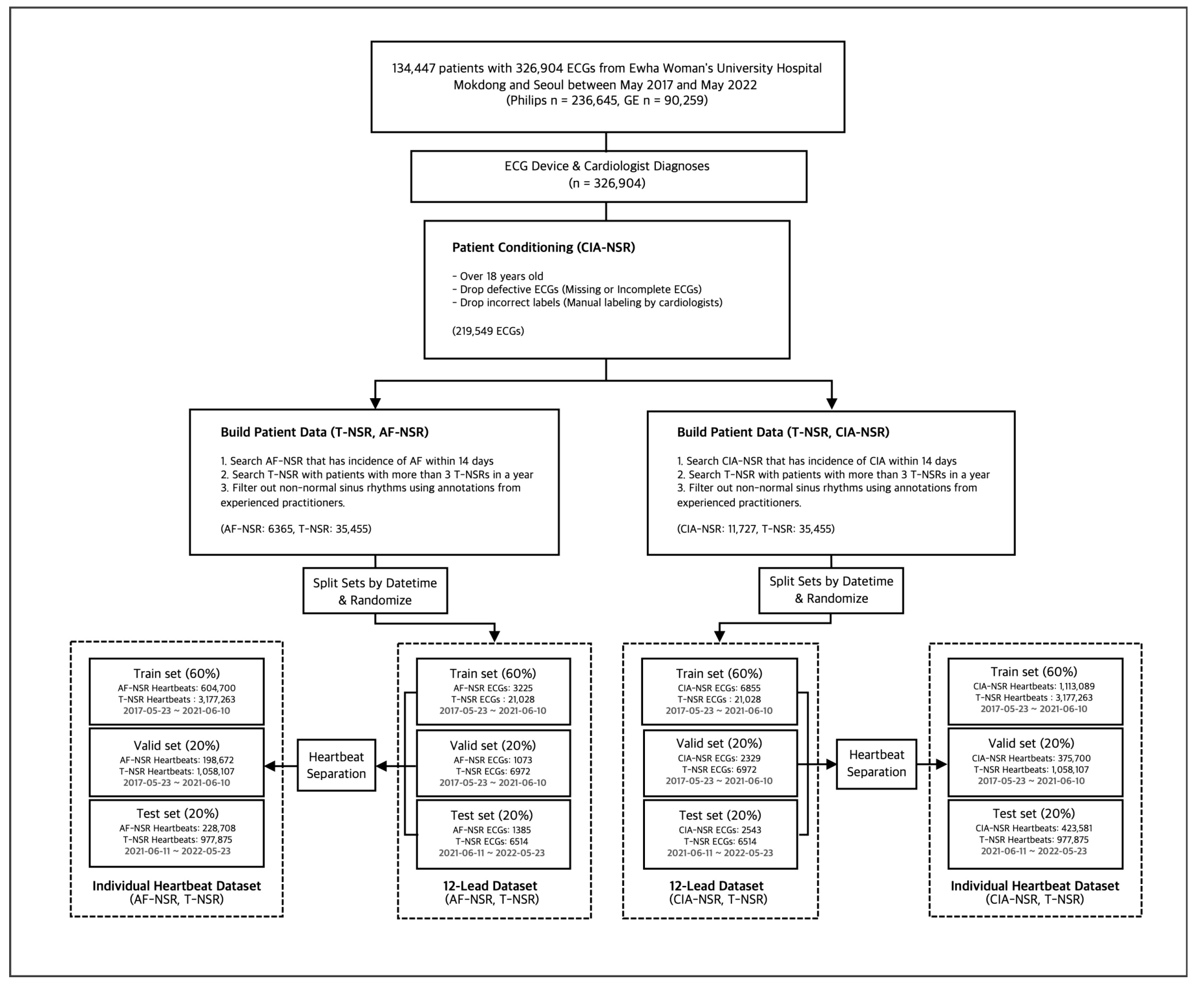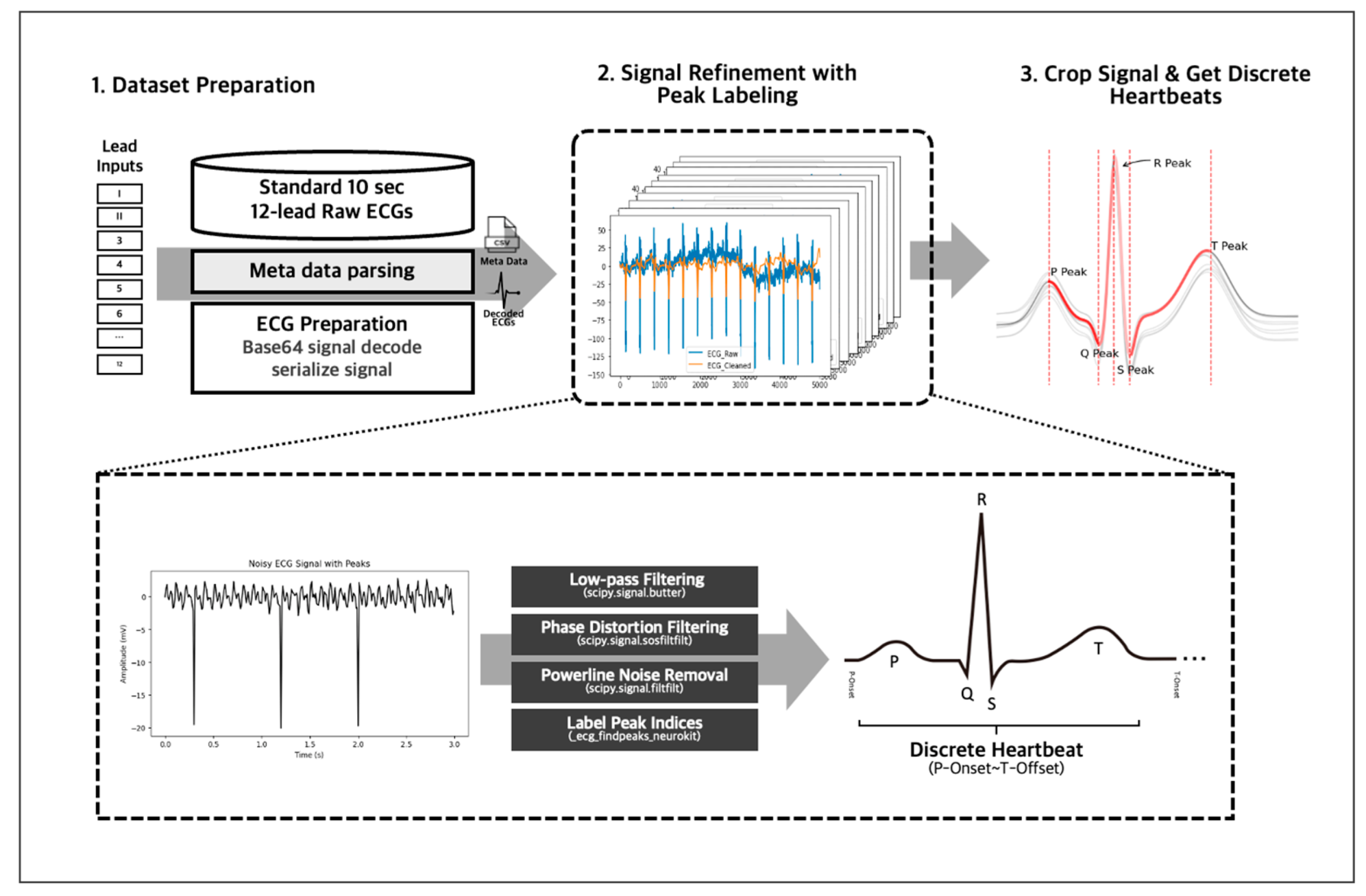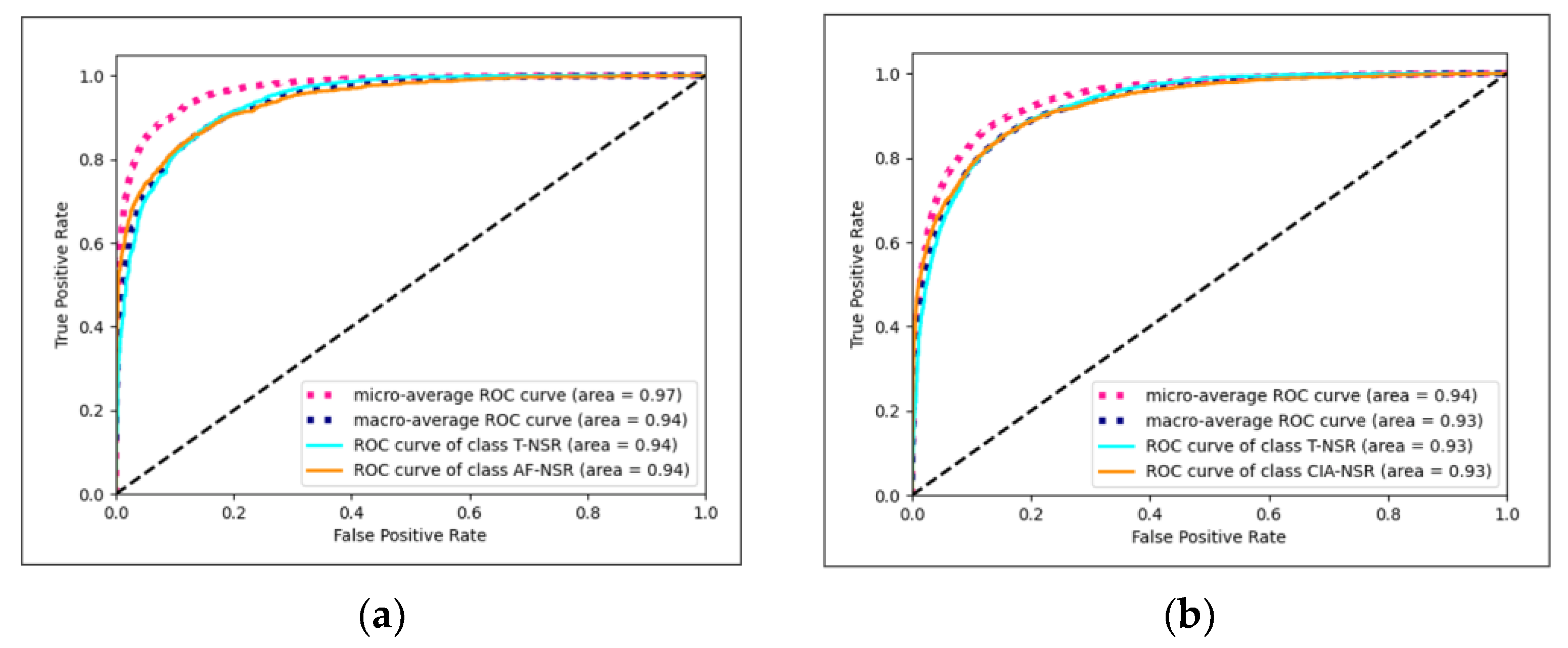Predicting Future Incidences of Cardiac Arrhythmias Using Discrete Heartbeats from Normal Sinus Rhythm ECG Signals via Deep Learning Methods
Abstract
:1. Introduction
2. Materials and Methods
2.1. Data Information and Study Population
2.2. Study Group Selection
2.2.1. Study Group Selection with Automated Labels
2.2.2. Study Group Selection with Manual Labels
2.3. Signal Data Preprocessing
2.4. Overview of the Model Development
2.4.1. Model Input Length
2.4.2. Model Architectures
2.4.3. Model Parameters and Thresholds
2.4.4. Ensemble Model for Generalizability
2.4.5. Metrics for Model Performance Evaluation
3. Results
3.1. Results for Different Architectures
3.2. Paired t-Test for Discrete Heartbeat and 12-Lead Input
4. Discussion
5. Conclusions
Author Contributions
Funding
Institutional Review Board Statement
Informed Consent Statement
Data Availability Statement
Conflicts of Interest
References
- Page, R.L.; Wilkinson, W.E.; Clair, W.K.; McCarthy, E.A.; Pritchett, E.L. Asymptomatic Arrhythmias in Patients with Symptomatic Paroxysmal Atrial Fibrillation and Paroxysmal Supraventricular Tachycardia. Circulation 1994, 89, 224–227. [Google Scholar] [CrossRef] [PubMed]
- Reiffel, J.A.; Verma, A.; Kowey, P.R.; Halperin, J.L.; Gersh, B.J.; Wachter, R.; Pouliot, E.; Ziegler, P.D. Incidence of Previously Undiagnosed Atrial Fibrillation Using Insertable Cardiac Monitors in a High-Risk Population. JAMA Cardiol. 2017, 2, 1120–1127. [Google Scholar] [CrossRef] [PubMed]
- Healey, J.S.; Connolly, S.J.; Gold, M.R.; Israel, C.W.; Van Gelder, I.C.; Capucci, A.; Lau, C.P.; Fain, E.; Yang, S.; Bailleul, C.; et al. Subclinical Atrial Fibrillation and the Risk of Stroke. N. Engl. J. Med. 2012, 366, 120–129. [Google Scholar] [CrossRef] [PubMed]
- Gopinathannair, R.; Etheridge, S.P.; Marchlinski, F.E.; Spinale, F.G.; Lakkireddy, D.; Olshansky, B. Arrhythmia-Induced Cardiomyopathies: Mechanisms, Recognition, and Management. J. Am. Coll. Cardiol. 2015, 66, 1714–1728. [Google Scholar] [CrossRef] [PubMed]
- Britton, M.; Gustafsson, C. Non-Rheumatic Atrial Fibrillation as a Risk Factor for Stroke. Stroke 1985, 16, 182–188. [Google Scholar] [CrossRef]
- Wolf, P.A.; Dawber, T.R.; Thomas, H.E.; Kannel, W.B. Epidemiologic Assessment of Chronic Atrial Fibrillation and Risk of Stroke: The Fiamingham Study. Neurology 1978, 28, 973. [Google Scholar] [CrossRef]
- Stewart, S.; Hart, C.L.; Hole, D.J.; McMurray, J.J.V. A Population-Based Study of the Long-Term Risks Associated with Atrial Fibrillation: 20-Year Follow-up of the Renfrew/Paisley Study. Am. J. Med. 2002, 113, 359–364. [Google Scholar] [CrossRef]
- Chugh, S.S.; Havmoeller, R.; Narayanan, K.; Singh, D.; Rienstra, M.; Benjamin, E.J.; Gillum, R.F.; Kim, Y.-H.; McAnulty, J.H.; Zheng, Z.-J.; et al. Worldwide Epidemiology of Atrial Fibrillation: A Global Burden of Disease 2010 Study. Circulation 2014, 129, 837–847. [Google Scholar] [CrossRef]
- Mozaffarian, D.; Benjamin, E.J.; Go, A.S.; Arnett, D.K.; Blaha, M.J.; Cushman, M.; Das, S.R.; De Ferranti, S.; Després, J.P.; Fullerton, H.J.; et al. Heart Disease and Stroke Statistics-2016 Update: A Report From the American Heart Association. Circulation 2016, 133, e38–e360. [Google Scholar]
- Mobile Photoplethysmographic Technology to Detect Atrial Fibrillation. J. Am. Coll. Cardiol. 2019, 74, 2365–2375. [CrossRef]
- Steinhubl, S.R.; Waalen, J.; Edwards, A.M.; Ariniello, L.M.; Mehta, R.R.; Ebner, G.S.; Carter, C.; Baca-Motes, K.; Felicione, E.; Sarich, T.; et al. Effect of a Home-Based Wearable Continuous ECG Monitoring Patch on Detection of Undiagnosed Atrial Fibrillation. JAMA 2018, 320, 146. [Google Scholar] [CrossRef] [PubMed]
- Raghunath, S.; Pfeifer, J.M.; Ulloa-Cerna, A.E.; Nemani, A.; Carbonati, T.; Jing, L.; van Maanen, D.P.; Hartzel, D.N.; Ruhl, J.A.; Lagerman, B.F.; et al. Deep Neural Networks Can Predict New-Onset Atrial Fibrillation from the 12-Lead ECG and Help Identify Those at Risk of Atrial Fibrillation–Related Stroke. Circulation 2021, 143, 1287–1298. [Google Scholar] [CrossRef]
- Baek, Y.-S.; Lee, S.-C.; Choi, W.; Kim, D.-H. A New Deep Learning Algorithm of 12-Lead Electrocardiogram for Identifying Atrial Fibrillation during Sinus Rhythm. Sci. Rep. 2021, 11, 12818. [Google Scholar] [CrossRef] [PubMed]
- Hendriks, J.M.L.; Fabritz, L. AI Can Now Identify Atrial Fibrillation through Sinus Rhythm. Lancet 2019, 394, 812–813. [Google Scholar] [CrossRef] [PubMed]
- Sanz-García, A.; Cecconi, A.; Vera, A.; Camarasaltas, J.M.; Alfonso, F.; Ortega, G.J.; Jimenez-Borreguero, J. Electrocardiographic Biomarkers to Predict Atrial Fibrillation in Sinus Rhythm Electrocardiograms. Heart (Br. Card. Soc.) 2021, 107, 1813–1819. [Google Scholar] [CrossRef] [PubMed]
- Christopoulos, G.; Graff-Radford, J.; Lopez, C.L.; Yao, X.; Attia, Z.I.; Rabinstein, A.A.; Petersen, R.C.; Knopman, D.S.; Mielke, M.M.; Kremers, W.; et al. Artificial Intelligence–Electrocardiography to Predict Incident Atrial Fibrillation. Circ. Arrhythmia Electrophysiol. 2020, 13, e009355. [Google Scholar] [CrossRef]
- Oh, S.L.; Ng, E.Y.K.; Tan, R.S.; Acharya, U.R. Automated Beat-Wise Arrhythmia Diagnosis Using Modified U-Net on Extended Electrocardiographic Recordings with Heterogeneous Arrhythmia Types. Comput. Biol. Med. 2019, 105, 92–101. [Google Scholar] [CrossRef]
- Degirmenci, M.; Ozdemir, M.A.; Izci, E.; Akan, A. Arrhythmic Heartbeat Classification Using 2D Convolutional Neural Networks. IRBM 2021, 45, 422–433. [Google Scholar] [CrossRef]
- Goldberger, E. The AVl, AVr, and AVf Leads. Am. Heart J. 1942, 24, 378–396. [Google Scholar] [CrossRef]
- Makowski, D.; Pham, T.; Lau, Z.J.; Brammer, J.C.; Lespinasse, F.; Pham, H.; Schölzel, C.; Chen, S.H.A. NeuroKit2: A Python Toolbox for Neurophysiological Signal Processing. Behav. Res. Methods 2021, 53, 1689–1696. [Google Scholar] [CrossRef]
- Jing, E.; Zhang, H.; Li, Z.; Liu, Y.; Ji, Z.; Ganchev, I. ECG Heartbeat Classification Based on an Improved ResNet-18 Model. Comput. Math. Methods Med. 2021, 2021, 6649970. [Google Scholar] [CrossRef]
- Cao, M.; Zhao, T.; Li, Y.; Zhang, W.; Benharash, P.; Ramezani, R. ECG Heartbeat Classification Using Deep Transfer Learning with Convolutional Neural Network and STFT Technique. J. Phys. Conf. Ser. 2023, 2547, 012031. [Google Scholar] [CrossRef]
- Zhao, D.; Jiang, R.; Feng, M.; Yang, J.; Wang, Y.; Hou, X.; Wang, X. A Deep Learning Algorithm Based on 1D CNN-LSTM for Automatic Sleep Staging. Technol. Health Care 2021, 30, 323–336. [Google Scholar] [CrossRef]
- Han, S.; Lee, W.; Eom, H.; Kim, J.; Park, C. Detection of Arrhythmia Using 1D Convolution Neural Network with LSTM Model. IEIE Trans. Smart Process. Comput. 2020, 9, 261–265. [Google Scholar] [CrossRef]
- Che, C.; Zhang, P.; Zhu, M.; Qu, Y.; Jin, B. Constrained Transformer Network for ECG Signal Processing and Arrhythmia Classification. BMC Med. Inform. Decis. Mak. 2021, 21, 184. [Google Scholar] [CrossRef] [PubMed]
- Basodi, S.; Ji, C.; Zhang, H.; Pan, Y. Gradient Amplification: An Efficient Way to Train Deep Neural Networks. Big Data Min. Anal. 2020, 3, 196–207. [Google Scholar] [CrossRef]
- Salehinejad, H.; Sankar, S.; Barfett, J.; Colak, E.; Valaee, S. Recent Advances in Recurrent Neural Networks. arXiv 2018, arXiv:1801.01078. [Google Scholar]
- Xu, Y.; Zhang, Q.; Zhang, J.; Tao, D. ViTAE: Vision Transformer Advanced by Exploring Intrinsic Inductive Bias. Semantic Scholar. Available online: https://www.semanticscholar.org/paper/ViTAE%3A-Vision-Transformer-Advanced-by-Exploring-Xu-Zhang/576c462dbc1f3d732b919ef1daac37a817123e52 (accessed on 29 August 2023).
- Lipton, Z.C.; Elkan, C.; Naryanaswamy, B. Optimal Thresholding of Classifiers to Maximize F1 Measure. Mach. Learn. Knowl. Discov. Databases 2014, 8725, 225–239. [Google Scholar] [CrossRef]
- Renda, A.; Barsacchi, M.; Bechini, A.; Marcelloni, F. Comparing Ensemble Strategies for Deep Learning: An Application to Facial Expression Recognition. Expert Syst. Appl. 2019, 136, 1–11. [Google Scholar] [CrossRef]
- Lindberg, T.; Wimo, A.; Elmståhl, S.; Qiu, C.; Bohman, D.M.; Sanmartin Berglund, J. Prevalence and Incidence of Atrial Fibrillation and Other Arrhythmias in the General Older Population: Findings from the Swedish National Study on Aging and Care. Gerontol. Geriatr. Med. 2019, 5, 233372141985968. [Google Scholar] [CrossRef]
- Chang, C.-H.; Lin, C.-S.; Luo, Y.-S.; Lee, Y.-T.; Lin, C. Electrocardiogram-Based Heart Age Estimation by a Deep Learning Model Provides More Information on the Incidence of Cardiovascular Disorders. Front. Cardiovasc. Med. 2022, 9, 754909. [Google Scholar] [CrossRef] [PubMed]
- Hirota, N.; Suzuki, S.; Arita, T.; Yagi, N.; Otsuka, T.; Yamashita, T. Prediction of Biological Age and All-Cause Mortality by 12-Lead Electrocardiogram in Patients without Structural Heart Disease. BMC Geriatr. 2021, 21, 460. [Google Scholar] [CrossRef] [PubMed]
- Attia, Z.I.; Friedman, P.A.; Noseworthy, P.A.; Lopez-Jimenez, F.; Ladewig, D.J.; Satam, G.; Pellikka, P.A.; Munger, T.M.; Asirvatham, S.J.; Scott, C.G.; et al. Age and Sex Estimation Using Artificial Intelligence from Standard 12-Lead ECGs. Circ. Arrhythmia Electrophysiol. 2019, 12, e007284. [Google Scholar] [CrossRef] [PubMed]
- Park, J.; Kim, T.H.; Lee, J.S.; Park, J.K.; Uhm, J.S.; Joung, B.; Lee, M.H.; Pak, H.N. Prolonged PR Interval Predicts Clinical Recurrence of Atrial Fibrillation after Catheter Ablation. J. Am. Heart Assoc. 2014, 3, e001277. [Google Scholar] [CrossRef] [PubMed]
- Lee, R.; Mittal, S. Utility and Limitations of Long-Term Monitoring of Atrial Fibrillation Using an Implantable Loop Recorder. Heart Rhythm 2018, 15, 287–295. [Google Scholar] [CrossRef]








| AF-NSR/T-NSR | Number of Heartbeats | Number of ECGs | |
|---|---|---|---|
| T-NSR | Training | 3,177,263 | 21,028 |
| Validation | 1,058,107 | 6972 | |
| Testing | 977,875 | 6514 | |
| AF-NSR | Training | 604,700 | 3225 |
| Validation | 198,672 | 1073 | |
| Testing | 228,708 | 1385 | |
| CIA-NSR/T-NSR | Number of Heartbeats | Number of ECGs | |
|---|---|---|---|
| T-NSR | Training | 3,177,263 | 21,028 |
| Validation | 1,058,107 | 6972 | |
| Testing | 977,875 | 6514 | |
| CIA-NSR | Training | 1,113,089 | 6855 |
| Validation | 375,700 | 2329 | |
| Testing | 423,581 | 2543 | |
| AF-NSR/T-NSR | Input | ResNet-18 | Conv1D+ LSTM | Conv1D+ Transformer |
|---|---|---|---|---|
| Average F1 | Heartbeat | 0.8468 | 0.8499 | 0.8371 |
| 12-Lead | 0.8302 | 0.8078 | 0.7837 | |
| Average AUC | Heartbeat | 0.9392 | 0.9419 | 0.9318 |
| 12-Lead | 0.9278 | 0.9124 | 0.8982 | |
| T-NSR F1 | Heartbeat | 0.9580 | 0.9596 | 0.9570 |
| 12-Lead | 0.9564 | 0.9499 | 0.9440 | |
| AF-NSR F1 | Heartbeat | 0.7357 | 0.7402 | 0.7171 |
| 12-Lead | 0.7039 | 0.6656 | 0.6234 | |
| T-NSR Precision | Heartbeat | 0.9276 | 0.9367 | 0.9408 |
| 12-Lead | 0.9302 | 0.9131 | 0.9070 | |
| AF-NSR Precision | Heartbeat | 0.7981 | 0.8108 | 0.8232 |
| 12-Lead | 0.7947 | 0.7343 | 0.6618 | |
| T-NSR Recall | Heartbeat | 0.9904 | 0.9837 | 0.9738 |
| 12-Lead | 0.9841 | 0.9898 | 0.9841 | |
| AF-NSR Recall | Heartbeat | 0.6823 | 0.6809 | 0.6352 |
| 12-Lead | 0.6318 | 0.6087 | 0.5892 | |
| T-NSR NPV | Heartbeat | 0.9105 | 0.8693 | 0.8124 |
| 12-Lead | 0.8639 | 0.8875 | 0.8230 | |
| AF-NSR NPV | Heartbeat | 0.9458 | 0.9457 | 0.9382 |
| 12-Lead | 0.9378 | 0.9336 | 0.9295 |
| CIA-NSR/T-NSR | Input | ResNet-18 | Conv1D+ LSTM | Conv1D+ Transformer |
|---|---|---|---|---|
| Average F1 | Heartbeat | 0.8361 | 0.8365 | 0.8392 |
| 12-Lead | 0.8317 | 0.8049 | 0.7903 | |
| Average AUC | Heartbeat | 0.9272 | 0.9222 | 0.9248 |
| 12-Lead | 0.9184 | 0.8909 | 0.8789 | |
| T-NSR F1 | Heartbeat | 0.9149 | 0.9131 | 0.9161 |
| 12-Lead | 0.9130 | 0.8975 | 0.8904 | |
| CIA-NSR F1 | Heartbeat | 0.7570 | 0.7601 | 0.7623 |
| 12-Lead | 0.7505 | 0.7122 | 0.6902 | |
| T-NSR Precision | Heartbeat | 0.8675 | 0.8753 | 0.8719 |
| 12-Lead | 0.8604 | 0.8425 | 0.8407 | |
| CIA-NSR Precision | Heartbeat | 0.8056 | 0.7731 | 0.8070 |
| 12-Lead | 0.7941 | 0.6990 | 0.6682 | |
| T-NSR Recall | Heartbeat | 0.9678 | 0.9539 | 0.9669 |
| 12-Lead | 0.9725 | 0.9602 | 0.9464 | |
| CIA-NSR Recall | Heartbeat | 0.7137 | 0.7475 | 0.7324 |
| 12-Lead | 0.7114 | 0.7259 | 0.7137 | |
| T-NSR NPV | Heartbeat | 0.8827 | 0.8468 | 0.8026 |
| 12-Lead | 0.8943 | 0.8414 | 0.7975 | |
| CIA-NSR NPV | Heartbeat | 0.8930 | 0.9027 | 0.8927 |
| 12-Lead | 0.8917 | 0.8914 | 0.8852 |
| AF-NSR/T-NSR | Input | ResNet-18 | Conv1D+ LSTM | Conv1D+ Transformer |
|---|---|---|---|---|
| Average F1 | Heartbeat | 0.8480 | 0.8650 | 0.8373 |
| 12-Lead | 0.8502 | 0.8118 | 0.7984 | |
| Average AUC | Heartbeat | 0.9451 | 0.9523 | 0.9134 |
| 12-Lead | 0.9314 | 0.9136 | 0.8842 | |
| T-NSR F1 | Heartbeat | 0.9661 | 0.9692 | 0.9242 |
| 12-Lead | 0.9674 | 0.9596 | 0.9068 | |
| AF-NSR F1 | Heartbeat | 0.7300 | 0.7607 | 0.7503 |
| 12-Lead | 0.7330 | 0.6641 | 0.6900 | |
| T-NSR Precision | Heartbeat | 0.9469 | 0.9547 | 0.8826 |
| 12-Lead | 0.9462 | 0.9309 | 0.8621 | |
| AF-NSR Precision | Heartbeat | 0.7520 | 0.8044 | 0.7524 |
| 12-Lead | 0.8083 | 0.6978 | 0.6771 | |
| T-NSR Recall | Heartbeat | 0.9861 | 0.9842 | 0.9699 |
| 12-Lead | 0.9895 | 0.9901 | 0.9571 | |
| AF-NSR Recall | Heartbeat | 0.7092 | 0.7216 | 0.7482 |
| 12-Lead | 0.6705 | 0.6334 | 0.7033 | |
| T-NSR NPV | Heartbeat | 0.8585 | 0.8550 | 0.7928 |
| 12-Lead | 0.8885 | 0.8701 | 0.8078 | |
| AF-NSR NPV | Heartbeat | 0.9597 | 0.9616 | 0.9084 |
| 12-Lead | 0.9550 | 0.9494 | 0.8996 |
| CIA-NSR/T-NSR | Input | ResNet-18 | Conv1D+ LSTM | Conv1D+ Transformer |
|---|---|---|---|---|
| Average F1 | Heartbeat | 0.8320 | 0.8268 | 0.817 |
| 12-Lead | 0.8259 | 0.8064 | 0.7984 | |
| Average AUC | Heartbeat | 0.9196 | 0.9105 | 0.9108 |
| 12-Lead | 0.9144 | 0.8847 | 0.8842 | |
| T-NSR F1 | Heartbeat | 0.9223 | 0.9202 | 0.9136 |
| 12-Lead | 0.9188 | 0.9117 | 0.9068 | |
| CIA-NSR F1 | Heartbeat | 0.7417 | 0.7334 | 0.7204 |
| 12-Lead | 0.7330 | 0.7011 | 0.6900 | |
| T-NSR Precision | Heartbeat | 0.8827 | 0.8827 | 0.8845 |
| 12-Lead | 0.8742 | 0.8631 | 0.8616 | |
| CIA-NSR Precision | Heartbeat | 0.7676 | 0.7572 | 0.7634 |
| 12-Lead | 0.7574 | 0.6938 | 0.6771 | |
| T-NSR Recall | Heartbeat | 0.9656 | 0.9610 | 0.9447 |
| 12-Lead | 0.9682 | 0.9662 | 0.9571 | |
| CIA-NSR Recall | Heartbeat | 0.7175 | 0.7110 | 0.6820 |
| 12-Lead | 0.7101 | 0.7085 | 0.7033 | |
| T-NSR NPV | Heartbeat | 0.8566 | 0.8410 | 0.8024 |
| 12-Lead | 0.8674 | 0.8424 | 0.8078 | |
| CIA-NSR NPV | Heartbeat | 0.9076 | 0.9054 | 0.9014 |
| 12-Lead | 0.9028 | 0.9019 | 0.8996 |
| AF-NSR/T-NSR | ResNet-18 | Conv1D+ LSTM | Conv1D+ Transformer |
|---|---|---|---|
| p-value Avg. F1 | 0.0119 | 0.0081 | 0.0230 |
| p-value Avg. AUC | 0.0393 | 0.0042 | 0.0104 |
| CIA-NSR/T-NSR | ResNet-18 | Conv1D+ LSTM | Conv1D+ Transformer |
|---|---|---|---|
| p-value Avg. F1 | 0.0434 | 0.0092 | 0.009 |
| p-value Avg. AUC | 0.0253 | 0.0132 | 0.0126 |
| AF-NSR/T-NSR | ResNet-18 | Conv1D+ LSTM | Conv1D+ Transformer |
|---|---|---|---|
| p-value Avg. F1 | 0.0089 | 0.0083 | 0.015 |
| p-value Avg. AUC | 0.0165 | 0.0048 | 0.0091 |
| CIA-NSR/T-NSR | ResNet-18 | Conv1D+ LSTM | Conv1D+ Transformer |
|---|---|---|---|
| p-value Avg. F1 | 0.0233 | 0.0075 | 0.0106 |
| p-value Avg. AUC | 0.0212 | 0.0094 | 0.0107 |
Disclaimer/Publisher’s Note: The statements, opinions and data contained in all publications are solely those of the individual author(s) and contributor(s) and not of MDPI and/or the editor(s). MDPI and/or the editor(s) disclaim responsibility for any injury to people or property resulting from any ideas, methods, instructions or products referred to in the content. |
© 2023 by the authors. Licensee MDPI, Basel, Switzerland. This article is an open access article distributed under the terms and conditions of the Creative Commons Attribution (CC BY) license (https://creativecommons.org/licenses/by/4.0/).
Share and Cite
Kim, Y.; Lee, M.; Yoon, J.; Kim, Y.; Min, H.; Cho, H.; Park, J.; Shin, T. Predicting Future Incidences of Cardiac Arrhythmias Using Discrete Heartbeats from Normal Sinus Rhythm ECG Signals via Deep Learning Methods. Diagnostics 2023, 13, 2849. https://doi.org/10.3390/diagnostics13172849
Kim Y, Lee M, Yoon J, Kim Y, Min H, Cho H, Park J, Shin T. Predicting Future Incidences of Cardiac Arrhythmias Using Discrete Heartbeats from Normal Sinus Rhythm ECG Signals via Deep Learning Methods. Diagnostics. 2023; 13(17):2849. https://doi.org/10.3390/diagnostics13172849
Chicago/Turabian StyleKim, Yehyun, Myeonggyu Lee, Jaeung Yoon, Yeji Kim, Hyunseok Min, Hyungjoo Cho, Junbeom Park, and Taeyoung Shin. 2023. "Predicting Future Incidences of Cardiac Arrhythmias Using Discrete Heartbeats from Normal Sinus Rhythm ECG Signals via Deep Learning Methods" Diagnostics 13, no. 17: 2849. https://doi.org/10.3390/diagnostics13172849
APA StyleKim, Y., Lee, M., Yoon, J., Kim, Y., Min, H., Cho, H., Park, J., & Shin, T. (2023). Predicting Future Incidences of Cardiac Arrhythmias Using Discrete Heartbeats from Normal Sinus Rhythm ECG Signals via Deep Learning Methods. Diagnostics, 13(17), 2849. https://doi.org/10.3390/diagnostics13172849






